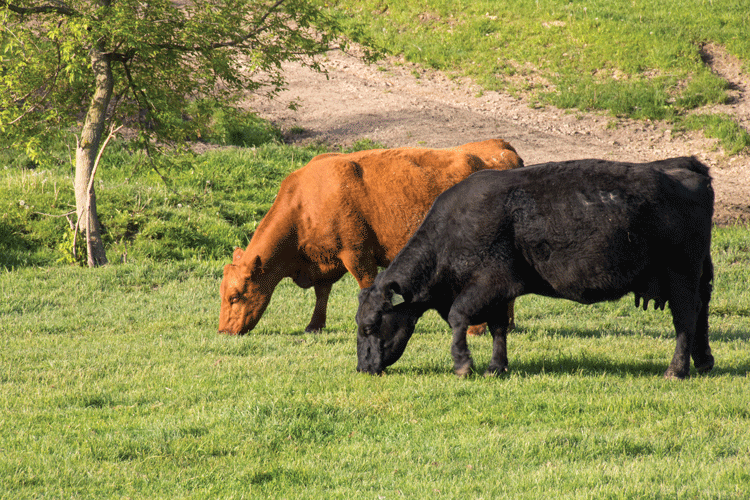Fewer cows but more net income |
| By Jason Banta |
|
|
|
The author is a beef cattle specialist for Texas A&M AgriLife Extension based in Overton, Texas.  When it comes to cow-calf production, it’s important to think about the big picture and how all decisions impact the operation. Is the goal to create a primary income for someone, generate supplementary income, or just for enjoyment with minimal losses? While it is tempting to look at gross income, the focus should be on net income and risk management. The strategy that generates the highest net return may not be the same every year. So, it is important to consider what strategies will work best for the operation and people over several years. Not maximizing potential income one year may be the best decision for the operation and may help generate more net income over multiple years. Net income is a function of both gross income and expenses. Net income can be increased by:
The long-term stocking rate for a property is one of the biggest factors impacting net income. In an effort to boost gross income, pastures are often overstocked, which leads to significantly higher expenses, lower weaning weights, and often reduced pregnancy rates. If properties are stocked to use all of the forage during good times, that means they are overstocked when forage is short. Having some forage left ungrazed can be beneficial for stand health and future forage potential. It may be tempting to acquire more cow numbers in anticipation of the higher cattle prices that are expected in the coming years, but it is critical not to overstock the property. Additionally, for those producers who have recently experienced drought, be aware that forage production will likely be reduced after drought conditions. How does stocking rate affect weaning weights and pregnancy rates? Stocking rates impact both the quantity and quality of forage available for grazing. Forage quality varies throughout the plant. As a general rule, quality is highest in the top third of growth and lowest in the bottom third. Falling dominoes When forage quantity is reduced, cattle are not able to be as selective in what they graze and end up consuming a lower-quality diet. This leads to reduced milk production and cow body condition score. Less milk production leads to lower weaning weights. Weaning weights are also inhibited because calves are consuming lower-quality forage. Cow body condition score is the main factor impacting pregnancy rates most of the time. The following example illustrates how fewer cows may generate more net income for an operation. Consider a property with 100 grazeable acres that, under the best conditions, may be stocked with 33 cow-calf pairs (three acres per pair) compared to that same property stocked with 25 pairs (four acres per pair) or even 20 pairs (five acres per pair). Assuming a weaned calf crop of 78% to 80%, an estimated gross income per year can be calculated for each situation. Calf prices have been adjusted slightly to account for higher weaning weights as stocking rates are decreased.
Without considering expenses, it looks like stocking the property with 33 cows is the way to go, as it creates the most gross income. However, the question that must be asked is how much can expenses (for example, fertilizer, feed, spraying, and so forth) be reduced if the operation only had 25 cows. If expenses could be reduced by more than $5,350 per year, then the net return would be greater by only running 25 cows compared with 33 cows. In addition, running fewer cows would also reduce risk during times of drought or higher input costs. Opportunities for savings With fewer cows, less hay would need to be fed. Supplementation would also be reduced by running fewer cows because cows could select a higher-quality diet and stay in better body condition. Fewer cows may also mean lower spraying costs (reduced frequency and amount) because the additional forage would help shade out a lot of weeds. For the example above, reducing costs by $5,350 only means lowering costs by $53.50 per acre. Assuming a cost of 82 cents per pound of nitrogen, just reducing nitrogen fertilizer by 70 pounds per acre would save $57.40 per acre. This reduction would be both realistic and appropriate in this situation, and a larger reduction in nitrogen fertilizer would be possible in some cases. Reducing nitrogen fertilizer can be a good strategy, but cow numbers should be trimmed accordingly to prevent overgrazing. Additional savings from reduced hay and supplementation needs would result in even greater net income in this example. For those producers whose primary goal is enjoyment, then just running 20 cows would be a great choice. It would minimize hay and supplementation feeding the most and provide the greatest risk management to prevent herd reductions during times of drought. The strategies to generate the greatest net return will vary, but for many operations, reducing cow numbers can be a good approach, and it also helps reduce risk. This article appeared in the March 2023 issue of Hay & Forage Grower on page 18. Not a subscriber? Click to get the print magazine. |
